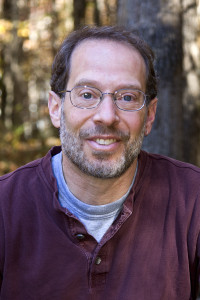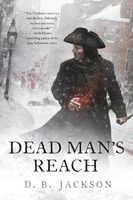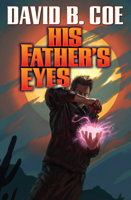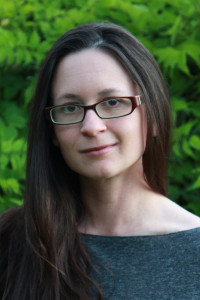 David B. Coe/D.B. Jackson is the award-winning author of eighteen fantasy novels. Under the name D.B. Jackson, he writes the Thieftaker Chronicles, a historical urban fantasy from Tor Books that includes Thieftaker
David B. Coe/D.B. Jackson is the award-winning author of eighteen fantasy novels. Under the name D.B. Jackson, he writes the Thieftaker Chronicles, a historical urban fantasy from Tor Books that includes Thieftaker, Thieves’ Quarry
, A Plunder of Souls
, and, the newest volume, Dead Man’s Reach
, which was released on July 21.
Meanwhile, under his own name, David writes The Case Files of Justis Fearsson, a contemporary urban fantasy from Baen Books. The first volume of this series, Spell Blind, debuted in January 2015. The newest book , His Father’s Eyes
, comes out on August 4.
He lives on the Cumberland Plateau with his wife and two daughters. They’re all smarter and prettier than he is, but they keep him around because he makes a mean vegetarian fajita.
When he’s not writing, he likes to hike, play guitar, and stalk the perfect image with his camera.
You have a couple of releases this summer. What can you tell me about them?
Yes, I have two books coming out under two different names, in two series, from two publishers, which is all a bit odd. The first, which came out on July 21 is Dead Man’s Reach, the fourth volume of the Thieftaker Chronicles, a historical urban fantasy that I write for Tor Books under the name D.B. Jackson. The series is set in pre-Revolutionary Boston and features a conjurer and thieftaker (sort of an 18th century private detective) named Ethan Kaille. Each book is set against the backdrop of some key event leading to the American Revolution. The action in this newest one coincides with the Boston Massacre.
The other novel coming out this summer is called His Father’s Eyes. It’s the second installment in a contemporary urban fantasy called The Case Files of Justis Fearsson, which I write under my own name for Baen Books. Jay Fearsson, my hero, is a weremyste. He’s a runecrafter, who can cast a variety of powerful spells. But every month, on the full moon and the nights immediately before and after, he goes temporarily mad, even as his power grows. Eventually the cumulative effect of these moon phasings will drive him permanently insane, as they have his father, who’s also a weremyste. As the title of the new book suggests, the relationship between Jay and his dad is central to the story, which also involves, a failed terrorist plot, a series of ritual killings, and an encounter with a werecoyote who lives in a singlewide trailer.
So two series, two identities . . . Does that get confusing?
 Well, I’ve been known to sign the wrong name in the occasional book, but other than that, not really. The two series have certain things in common both protagonists are conjuring investigators, the books in both series are standalones loosely linked by my character arcs, and both rely on certain urban fantasy tropes: the ghostly spirit guide, the noir voice, the powerfully ambient setting.
Well, I’ve been known to sign the wrong name in the occasional book, but other than that, not really. The two series have certain things in common both protagonists are conjuring investigators, the books in both series are standalones loosely linked by my character arcs, and both rely on certain urban fantasy tropes: the ghostly spirit guide, the noir voice, the powerfully ambient setting.
In other ways, though, the books are very different. In part because one is historical and the other is contemporary, the narrative voices are quite distinct. And from a writing perspective, each story presents unique challenges. So it turns out that when I’m writing as D.B. Jackson, I feel very much immersed in that world, and the same is true when I’m writing under my own name. Plus, shifting between the two keeps my writing fresh.
Urban fantasy is sometimes thought of as a subgenre dominated by female authors writing female protagonists, and yet here you are writing two series in the genre, both featuring male heroes. Why go that route?
I was aware of the dynamic. There are a few prominent examples of men writing about men in the field Jim Butcher’s Harry Dresden books, of course; Kevin Hearne’s Iron Mage series; Richard Kadrey’s Sandman Slim novels. But they do seem to be the exceptions, and I can name so many female authors doing terrific work in urban fantasy: Kim Harrison, Laurel K. Hamilton, Patricia Briggs, Faith Hunter, C.E. Murphy, Kat Richardson, and many more.
One of the reasons I chose the D.B. Jackson pseudonym when I first started writing UF, was that I wanted to use a genderneutral pen name. It used to be that women in fantasy and SF had to “disguise themselves” by camouflaging their names as I have. Today, in a welcome turnabout, it’s us guys who have to do that, at least in this subgenre.
But I also think that there is room in urban fantasy for all of us, male and female. I try to draw my heroes as honestly as I can. I make them wellrounded. They have a dark side, they have a sensitive side. They can act like typical guys, but they can also be tender, loving, vulnerable. In short, they’re not “male characters” so much as they’re people. And I surround them with strong female characters colleagues, rivals, love interests who are realistic and balanced as well.
Tell us a bit more about that. You are writing in two distinctly different time periods, the colonial era and the present day. Do you find that you need to treat your female characters in the two projects differently in order to make the books realistic?
Without trying to be glib, the answer is both yes and no. Yes, in that I make ALL my characters a bit different in the Thieftaker books. They speak differently, they have different sensibilities, their dayto-day concerns are not the same as ours. In order for those books to ring true, I have my characters speak in something that approximates an 18th century lexicon (while still making their dialog decipherable for a modern audience), and I make them behave and dress in ways that are appropriate to their time. So, for instance, my female characters all wear dresses. (Except for Sephira Pryce, Ethan Kaille’s rival in thieftaking, who wears breeches and a waistcoat, as would a man working in the streets. I’ll get to Sephira in a moment, because she is a special case.) In the same way, I do not have women in positions of political power, because there were no women in such offices in the 1760s.
But in other ways, the women in the Thieftaker books are every bit as strong and independent as women in the Fearsson books, and this comes as something of a surprise to some people. The fact is though (putting on my hat as history Ph.D.) the strict circumscribing of women’s societal roles, something we generally associate loosely with “the past,” was a nineteenth and early twentieth century phenomenon. Women in the eighteenth century had far more freedom, socially, sexually, economically, than their counterparts a century later. And so having Kannice Lester, a young widow who is Ethan’s love interest, own and run a tavern is perfectly legitimate historically. Janna Windcatcher, another tavern owner, is also black and free, which makes her somewhat unusual, but my no means anachronistic in pre-Revolutionary Boston.
The most unusual character is Sephira, who as a thieftaker and, essentially, a criminal, steps farthest from any examples I have found in the historical record. Honestly, I’m fine with that. Yes, I took a liberty with her, but she is such a fun character I really don’t care.
Having Ethan’s rival be a woman brilliant, ruthless, kickass, beautiful, overtly sexual infuses their interactions with a crackling energy, and gives incredible power to all of my plot lines.
The one thing I did in the Fearsson books that I didn’t do in the Thieftaker series was have openly gay characters of either gender. In The Case Files of Justis Fearsson, Jay’s closest friend and former partner on the police force is Kona Shaw, an African-American woman involved with Margarite Santos, a lawyer in the D.A.’s office. The reason I don’t have openly gay characters in the Thieftaker novels is that I didn’t know how to address the issue in a historically accurate way. Reliable records on the position of gays in colonial society are pretty hard to come by.
In every other way, though, the distance between the female characters in the Thieftaker books and those in the Fearsson books is far less than some might expect.
What’s up next for you after this summer’s releases?
 There’s still one more Fearsson book in the pipeline: SHADOW’S BLADE will be out next May. And I have been collaborating with Faith Hunter, author of the New York Times bestselling Jane Yellowrock books on a crossover project that combines her universe with the Thieftaker world. We released a novelette earlier this summer and we’d both like to write more in that mashup world.
There’s still one more Fearsson book in the pipeline: SHADOW’S BLADE will be out next May. And I have been collaborating with Faith Hunter, author of the New York Times bestselling Jane Yellowrock books on a crossover project that combines her universe with the Thieftaker world. We released a novelette earlier this summer and we’d both like to write more in that mashup world.
But aside from that, I’m not sure yet. I have an idea for a new epic fantasy, but it still needs a lot of prep work before I’ll be ready to write it. So I suppose I’ll be diving into that when the summer’s over.
_______________________________
As you can imagine, twice the number of pen names means there’s a whole lot of David B. Coe to be had on the Internet! As David B. Coe, he’s got a website, blog, Facebook page and Twitter feed, as well as an Amazon author page. Then as D.B. Jackson, he’s also got a whole other separate website. Enjoy!







